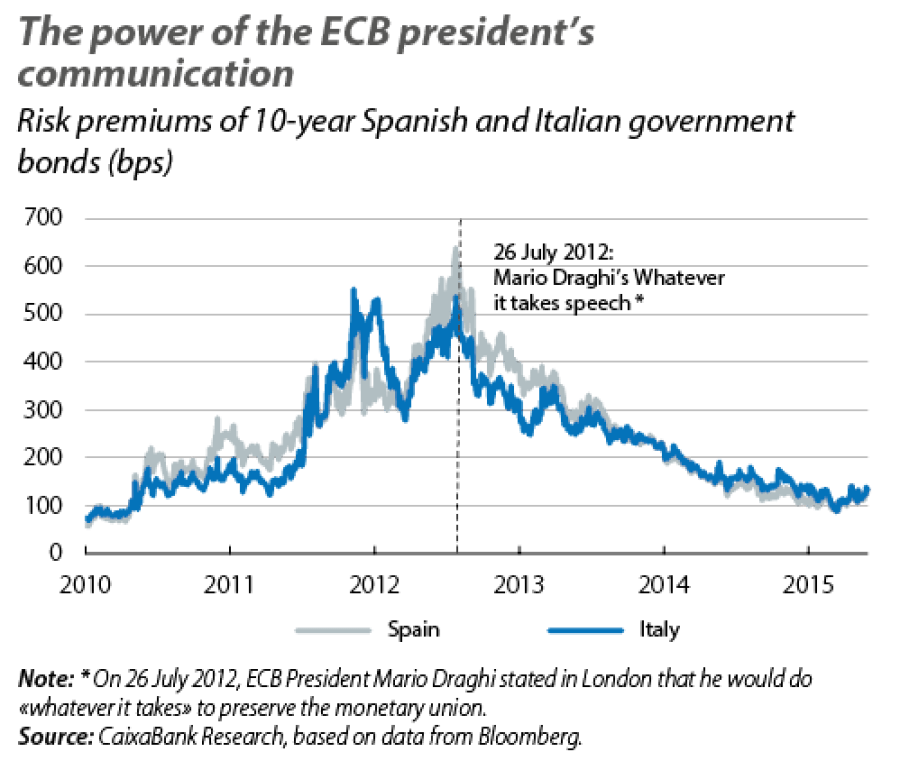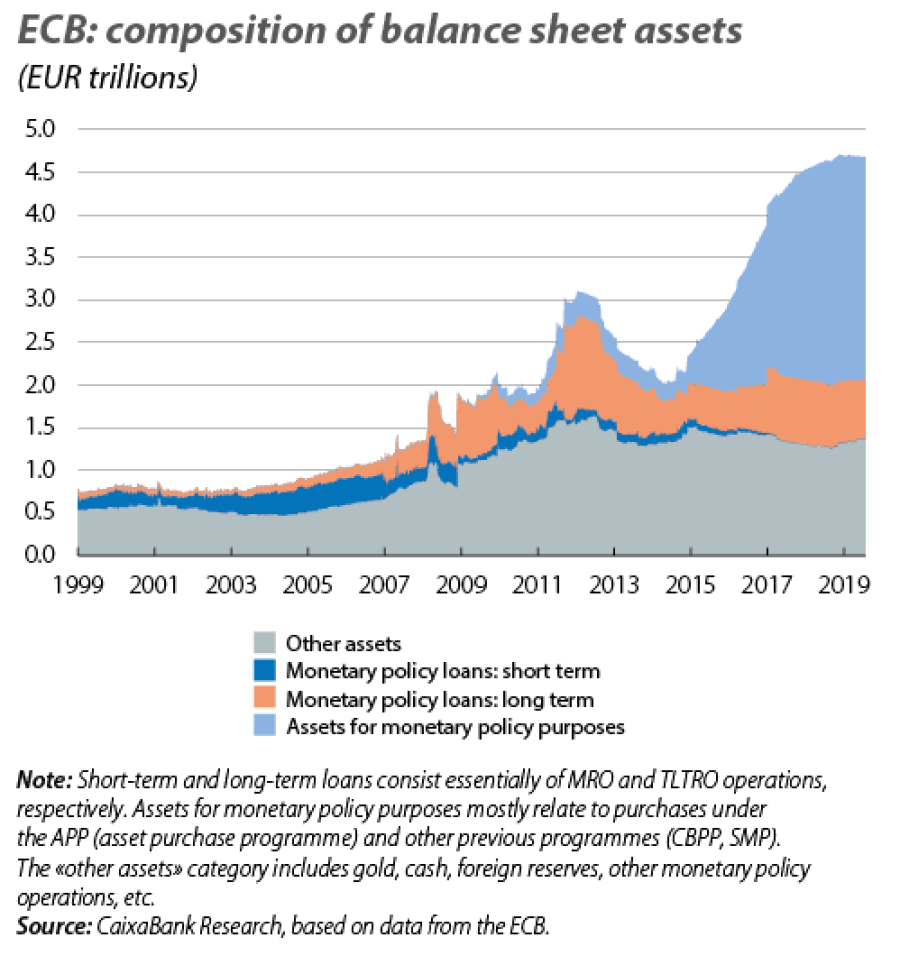The farewell of (Super) Mario Draghi
Following a September full of announcements, the next meeting of the ECB (24 October) will be one of transition, at least in one way: 31 October 2019 will mark the end the mandate of Mario Draghi, the most charismatic president1 in the institution’s history.

• Mario Draghi ends his eight-year mandate at the ECB on October 31, leaving the central bank at the cutting edge of monetary policy.
• Under Draghi’s leadership, the ECB has offered significant support to the recovery of the euro area. However, the latest measures have raised doubts over the margin for action and effectiveness of monetary policy.
• Christine Lagarde, with a less technical profile but a vision of continuity in monetary policy, will take over in a sombre economic environment in which signs of fragmentation between ECB members have appeared.
Following a September full of announcements, the next meeting of the ECB (24 October) will be one of transition, at least in one way: 31 October 2019 will mark the end the mandate of Mario Draghi, the most charismatic president1 in the institution’s history.
- 1. This is demonstrated by the various nicknames he has received during the course of his mandate: from «Super Mario» (a video game character) to the more recent «Dracula Draghi», coined by critics because of the low interest rates.
Draghi’s legacy will perhaps be summed up by his most famous phrase: Whatever it takes. With these three words, after just nine months in office, in 2012 Draghi put an end to the fear of the rupture of the euro area with the promise of leading an ECB that was willing to do whatever was necessary to ensure the euro’s survival (see first chart). With less than 15 years of history and having to tackle the most severe recession in recent decades, under Draghi’s mandate the ECB established itself as the great bastion for the stabilisation of the European economy and revolutionised the monetary policy of the euro area by adopting tools at the «cutting edge» of central bank policy: asset purchases, negative reference interest rates, intensive use of communication,2 injections of liquidity, etc.
- 2. The article «Mario Draghi and his “parole, parole”» in the MR01/2018 analyses the power of communication as a monetary policy tool.

This revolution is reflected in the ECB’s balance sheet, which has more than doubled in size (+150%) since 2011.3 Not only that, but its composition is also very revealing: as shown in the second chart, asset purchases and long-term loans have gone from being virtually non-existent in the pre-crisis period to representing 70% of the ECB’s balance sheet today, reflecting the intense use of unconventional monetary policy tools.4
- 3. As a percentage of GDP, the size of the ECB’s balance sheet (40%) clearly exceeds that of the Fed (slightly below 20%).
- 4. Behind this change lie, in particular, asset purchases amounting to 2.6 trillion euros as part of the APP (asset purchase programme) initiated in 2015 (mostly public and corporate debt) and several rounds of injections of liquidity into the financial system through long-term loans (the latest of which, TLTRO-III, was announced in March), with a current balance of 0.7 trillion euros.

All this has resulted in a highly accommodative monetary policy which, according to some estimates, would be the equivalent of having reduced the ECB’s interest rate to around –7%.5 In addition, whereas prior to the financial crisis monetary policy was much more suited to the needs of the core countries than to those of the periphery, between 2009 and 2015 the ECB found a middle ground between both areas. Since then, the third chart shows how monetary policy has left traditional rules behind6 and has entered increasingly accommodative territory. This is possibly because those rules are based on how the economy functions in normal times and do not reflect the concerns that are currently generating uncertainty, (geopolitics, but also the fragility of inflation and the true degree of the underutilisation of productive resources).7 In fact, one of Draghi’s greatest achievements has been his ability to achieve consensus on the implementation of this monetary policy despite the differences in the economies of the euro area.
- 5. These estimates are based on the so-called «shadow rate»: the refi interest rate that we would observe in the current environment if it were not pegged at 0%. J.C. Wu and F.D. Xia (2016). «Measuring the Macroeconomic Impact of Monetary Policy at the Zero Lower Bound». Journal of Money, Credit, and Banking. Also see the article «Discovering monetary policy in the shadow» in the MR02/2016.
- 6. Such as the Taylor rule, which tells us what the official interest rate should be, based on the natural rate of interest, inflation (core) and a measure of how far off economic activity is from its potential.
- 7. On the other hand, the divergence between traditional rules and the actual position of monetary policy also illustrates the existence of a debate around the suitability of the latest measures taken by the ECB.

It is estimated that the ECB’s measures, especially those announced since 2014, offered significant support for the recovery of the euro area. In particular, estimates (see fourth chart) suggest that the ECB was responsible for around 25% of the growth in economic activity and around 40% of the recovery in inflation between 2016 and 2018,8 with GDP growth in the euro area accelerating to 2.2% on average during these three years (1.1% in 2013-2015). As such, with core inflation approaching 1.5% in mid-2018, the ECB prepared to bring asset purchases to an end, to give indications of the first rate hike and, ultimately, to begin to withdraw the monetary stimulus.
- 8. ECB (2019), «Taking stock of the Eurosystem’s asset purchase programme after the end of net asset purchases». Economic Bulletin 02/2019.

However, the intensification and persistence of risks (such as geopolitical tensions, vulnerabilities in emerging economies or financial turbulences) and the moderation in economic activity they brought with them have led the ECB to make a U-turn. Draghi could have said farewell with the first rate hike, but he will do so with a new stimulus package launched in September: cutting the interest rate of the deposit facility by 10 bps (down to –0.50%) and the resumption of net asset purchases (QE) at a rate of 20 billion euros per month.9
These measures, however, have raised doubts over the ECB’s margin for action and its effectiveness. On the one hand, while the ECB argues that continuing with asset purchases will not cause any problems, estimates suggest that they may not last very long and that, under the current criteria, the ECB could run out of capacity to buy more public debt securities towards the end of 2020.10 On the other hand, with the latest rate cut, the ECB could be approaching the so-called «reversal threshold»: the level at which a further reduction in reference rates would have a contractionary effect on the economy. Specifically, the analysis of the sensitivity of interest rates on household and company deposits and loans to changes in ECB interest rates suggests that the «reversal threshold» could lie at around –1.0% (see last chart).11 Indeed, this estimate is similar to the results of more sophisticated analyses12 and relatively close to the –0.50% at which the interest rate of the ECB’s deposit facility currently stands.
- 9. In addition to better conditions for TLTRO-III, the package includes a tiered remuneration scheme and a communication that indicates that this new stimulus could continue for a long period of time.
- 10. The ECB has limited itself to purchasing no more than 33% of the assets of any given issuance or issuer and distributes the purchases according to the capital that each country contributes to the ECB. For example, cumulative purchases of German debt are already quickly approaching 30% of the total eligible stock of 1.5 billion euros: if public debt makes up 75% of new purchases (in line with the historic figure), and the fraction corresponding to Germany is around 25%, purchases of German debt would reach the 33% limit in around 12 months-time (in the absence of more issues arising, for instance, from a fiscal stimulus). In addition, while increasing the relative weight of purchases of corporate bonds or relaxing the limits would increase the margin for action, the very emergence of doubts reduces the effectiveness of the ECB’s monetary policy.
- 11. We estimate the regression
- 12. See M.K. Brunnermeier and Y. Koby (2018). «The reversal interest rate». National Bureau of Economic Research n° w25406. Also see Radde and Stehn (2019). «How much could the ECB cut?» Goldman Sachs European Economics Analyst.

Mario Draghi will hand over the baton to Christine Lagarde (nominated by European institutions last July) in a more sombre context than that expected a year ago. In addition, in the midst of the doubts over the new stimulus programme, signs of fragmentation among the members of the ECB have appeared: the governors of the central banks of Germany, the Netherlands and France (among others) have publicly expressed their opposition to the resumption of QE, and Sabine Lautenschläger, a member of the Executive Board, filed her resignation at the end of September.13 In this context, and despite having a less technical profile than her predecessor,14 the great communication skills and ability to generate consensus that Lagarde has demonstrated at the head of France’s Ministry of Economy and as managing director of the IMF will prove key. Indeed, these are positions in which she was on the front line of the economic transformations of the last decade and in which she has defended the unconventional tools and the shift in monetary policy implemented by Draghi.
- 13. With the end of the mandate of Benoit Creure, on 31 December 2019 another vacancy will appear. This will most likely be occupied by Fabio Panetta, who has a long history at the central bank of Italy.
- 14. Before leading the ECB, Mario Draghi, who holds a PhD in Economics from MIT, was a university professor, held senior positions in the Italian Ministry of the Treasury, at the World Bank and at Goldman Sachs, and was the governor of the central bank of Italy. Christine Lagarde, a lawyer by training, in 1999 became the first woman to lead the law firm Baker & McKenzie and has been the Minister for Economy, Finance and Industry of France between 2007 and 2011, and managing director of the IMF between 2011 and 2019.





